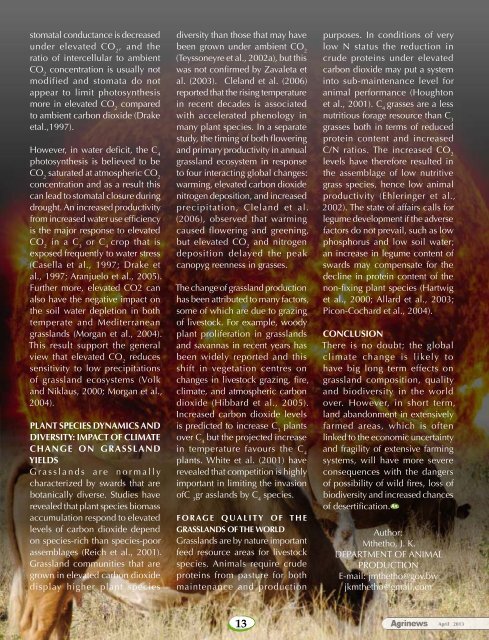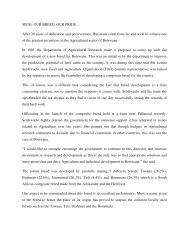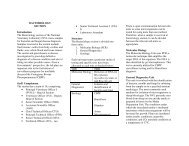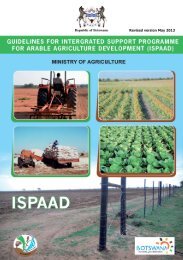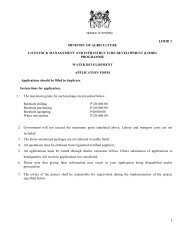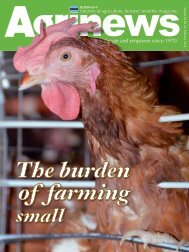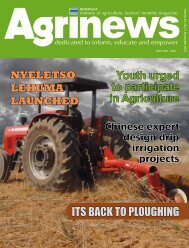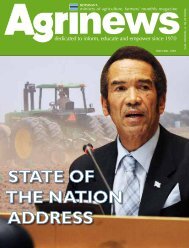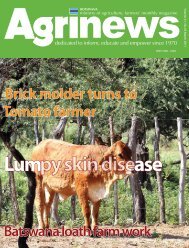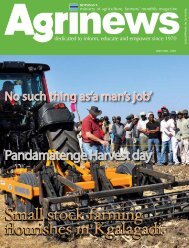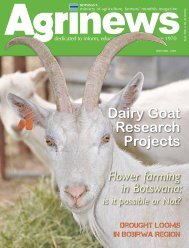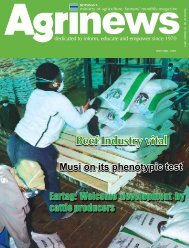Agrinews April 2013 - Ministry of Agriculture
Agrinews April 2013 - Ministry of Agriculture
Agrinews April 2013 - Ministry of Agriculture
- No tags were found...
You also want an ePaper? Increase the reach of your titles
YUMPU automatically turns print PDFs into web optimized ePapers that Google loves.
stomatalÊ conductanceÊ isÊ decreasedÊunder elevated CO 2,Ê andÊ theÊratioÊ <strong>of</strong>Ê intercellularÊ toÊ ambientÊCO 2Ê concentrationÊ isÊ usuallyÊ notÊmodifiedÊ andÊ stomataÊ doÊ notÊappearÊ toÊ limitÊ photosynthesisÊmore in elevated CO 2Ê comparedÊtoÊ ambientÊ carbonÊ dioxideÊ (DrakeÊetÊal.,Ê1997).However, in water deficit, the C 4ÊphotosynthesisÊ isÊ believedÊ toÊ beÊCO 2saturated at atmospheric CO 2ÊconcentrationÊ andÊ asÊ aÊ resultÊ thisÊcanÊ leadÊ toÊ stomatalÊ closureÊ duringÊdrought.ÊanÊ increasedÊ productivityÊfrom increased water use efficiencyisÊ theÊ majorÊ responseÊ toÊ elevatedÊCO 2Ê inÊ aÊ 3CÊ orÊ C 4ÊcropÊ thatÊ isÊexposedÊ frequentlyÊ toÊ waterÊ stressÊ(CasellaÊ etÊ al.,Ê 1997;Ê DrakeÊ etÊal.,Ê 1997;Ê aranjueloÊ etÊ al.,Ê 2005).ÊFurther more, elevated CO2 canalsoÊ haveÊ theÊ negativeÊ impactÊ onÊtheÊ soilÊ waterÊ depletionÊ inÊ bothÊtemperateÊ andÊ MediterraneanÊgrasslandsÊ (MorganÊ etÊ al.,Ê 2004).ÊThisÊ resultÊ supportÊ theÊ generalÊview that elevated CO 2Ê reducesÊsensitivityÊ toÊ lowÊ precipitationsÊ<strong>of</strong>Ê grasslandÊ ecosystemsÊ (VolkÊandÊ Niklaus,Ê 2000;Ê MorganÊ etÊ al.,Ê2004).PLANTÊ SPECIESÊ DYNAMICSÊ ANDÊDIVERSITY:Ê IMPACTÊ OFÊ CLIMATEÊCHANGEÊ ONÊ GRASSLANDÊYIELDSGrasslandsÊ areÊ normallyÊcharacterizedÊ byÊ swardsÊ thatÊ areÊbotanicallyÊ diverse.Ê StudiesÊ haveÊrevealedÊ thatÊ plantÊ speciesÊ biomassÊaccumulationÊ respondÊ toÊ elevatedÊlevelsÊ <strong>of</strong>Ê carbonÊ dioxideÊ dependÊonÊ species-richÊ thanÊ species-poorÊassemblagesÊ (ReichÊ etÊ al.,Ê 2001).ÊGrasslandÊ communitiesÊ thatÊ areÊgrownÊ inÊ elevatedÊ carbonÊ dioxideÊdisplayÊ higherÊ plantÊ speciesÊdiversityÊ thanÊ thoseÊ thatÊ mayÊ haveÊbeen grown under ambient CO 2Ê(TeyssoneyreÊ etÊ al.,Ê 2002a),Ê butÊ thisÊwas not confirmed by Zavaleta etal.Ê (2003).Ê Ê ClelandÊ etÊ al.Ê (2006)ÊreportedÊ thatÊ theÊ risingÊ temperatureÊinÊ recentÊ decadesÊ isÊ associatedÊwithÊ acceleratedÊ phenologyÊ inÊmanyÊ plantÊ species.Ê InÊ aÊ separateÊstudy, the timing <strong>of</strong> both floweringandÊ primaryÊ productivityÊ inÊ annualÊgrasslandÊ ecosystemÊ inÊ responseÊtoÊ fourÊ interactingÊ globalÊ changes:Êwarming,Ê elevatedÊ carbonÊ dioxideÊnitrogenÊ deposition,Ê andÊ increasedÊprecipitation,Ê ClelandÊ etÊ al.Ê(2006),Ê observedÊ thatÊ warmingÊcausedÊ floweringÊ andÊ greening,Êbut elevated CO 2Ê andÊ nitrogenÊdepositionÊ delayedÊ theÊ peakÊcanopyÊg reennessÊ inÊ grasses.TheÊ changeÊ <strong>of</strong>Ê grasslandÊ productionÊ non-fixing plant species (HartwighasÊ beenÊ attributedÊ toÊ manyÊ factors,ÊetÊ al.,Ê 2000;ÊallardÊ etÊ al.,Ê 2003;ÊsomeÊ <strong>of</strong>Ê whichÊ areÊ dueÊ toÊ grazingÊPicon-CochardÊ etÊ al.,Ê 2004).Ê<strong>of</strong>Ê livestock.Ê ForÊ example,Ê woodyÊplantÊ proliferationÊ inÊ grasslandsÊ CONCLUSIONÊandÊ savannasÊ inÊ recentÊ yearsÊ hasÊbeenÊ widelyÊ reportedÊ andÊ thisÊshiftÊ inÊ vegetationÊ centresÊ onÊchanges in livestock grazing, fire,climate,Ê andÊ atmosphericÊ carbonÊdioxideÊ (HibbardÊ etÊ al.,Ê 2005).ÊÊIncreasedÊ carbonÊ dioxideÊ levelsÊisÊ predictedÊ toÊ increaseÊ C 3Ê plantsÊoverÊ C 4Ê butÊ theÊ projectedÊ increaseÊinÊ temperatureÊ favoursÊ theÊ 4CÊplants.Ê whiteÊ etÊ al.Ê (2001)Ê haveÊrevealedÊ thatÊ competitionÊ isÊ highlyÊimportantÊ inÊ limitingÊ theÊ invasionÊ<strong>of</strong>ÊC 3Êgr asslandsÊ byÊ 4CÊ species.FORAGEÊ QUALITYÊ OFÊ THEÊGRASSLANDSÊ OFÊ THEÊ WORLDGrasslandsÊ areÊ byÊ natureÊ importantÊfeedÊ resourceÊ areasÊ forÊ livestockÊspecies.Ê animalsÊ requireÊ crudeÊproteinsÊ fromÊ pastureÊ forÊ bothÊmaintenanceÊ andÊ productionÊpurposes.Ê InÊ conditionsÊ <strong>of</strong>Ê veryÊlowÊ NÊ statusÊ theÊ reductionÊ inÊcrudeÊ proteinsÊ underÊ elevatedÊcarbonÊ dioxideÊ mayÊ putÊ aÊ systemÊintoÊ sub-maintenanceÊ levelÊ forÊanimalÊ performanceÊ (HoughtonÊetÊ al.,Ê 2001).Ê 4ÊCgrassesÊ areÊ aÊ lessÊnutritiousÊ forageÊ resourceÊ thanÊ 3ÊCgrassesÊ bothÊ inÊ termsÊ <strong>of</strong>Ê reducedÊproteinÊ contentÊ andÊ increasedÊC/N ratios. The increased CO 2ÊlevelsÊ haveÊ thereforeÊ resultedÊ inÊtheÊ assemblageÊ <strong>of</strong>Ê lowÊ nutritiveÊgrassÊ species,Ê henceÊ lowÊ animalÊproductivityÊ (EhleringerÊ etÊ al.,Ê2002).Ê TheÊ stateÊ <strong>of</strong>Ê affairsÊ callsÊ forÊlegumeÊ developmentÊ ifÊ theÊ adverseÊfactorsÊ doÊ notÊ prevail,Ê suchÊ asÊ lowÊphosphorusÊ andÊ lowÊ soilÊ water;ÊanÊ increaseÊ inÊ legumeÊ contentÊ <strong>of</strong>ÊswardsÊ mayÊ compensateÊ forÊ theÊdeclineÊ inÊ proteinÊ contentÊ <strong>of</strong>Ê theÊThereÊ isÊ noÊ doubt;Ê theÊ globalÊclimateÊ changeÊ isÊ likelyÊ toÊhaveÊ bigÊ longÊ termÊ effectsÊ onÊgrasslandÊ composition,Ê qualityÊandÊ biodiversityÊ inÊ theÊ worldÊover.Ê However,Ê inÊ shortÊ term,ÊlandÊ abandonmentÊ inÊ extensivelyÊfarmedÊ areas,Ê whichÊ isÊ <strong>of</strong>tenÊlinkedÊ toÊ theÊ economicÊ uncertaintyÊandÊ fragilityÊ <strong>of</strong>Ê extensiveÊ farmingÊsystems,Ê willÊ haveÊ moreÊ severeÊconsequencesÊ withÊ theÊ dangersÊ<strong>of</strong> possibility <strong>of</strong> wild fires, loss <strong>of</strong>biodiversityÊ andÊ increasedÊ chancesÊ<strong>of</strong> desertification.author:ÊMthetho,Ê J.Ê K.DEPARTMENT OF ANIMALPRODUCTIONE-mail:Ê jmthetho@gov.bwjkmthetho@gmail.com13<strong>April</strong>Ê Ê Ê <strong>2013</strong>


